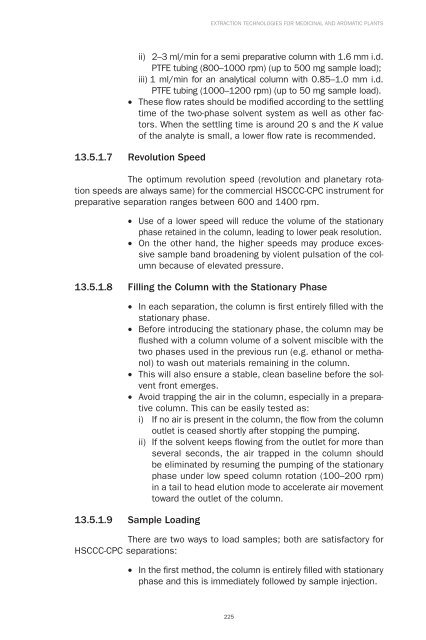Extraction Technologies For Medicinal And Aromatic Plants - Unido
Extraction Technologies For Medicinal And Aromatic Plants - Unido
Extraction Technologies For Medicinal And Aromatic Plants - Unido
Create successful ePaper yourself
Turn your PDF publications into a flip-book with our unique Google optimized e-Paper software.
EXTRACTION TECHNOLOGIES FOR MEDICINAL AND AROMATIC PLANTS<br />
ii) 2–3 ml/min for a semi preparative column with 1.6 mm i.d.<br />
PTFE tubing (800–1000 rpm) (up to 500 mg sample load);<br />
iii) 1 ml/min for an analytical column with 0.85–1.0 mm i.d.<br />
PTFE tubing (1000–1200 rpm) (up to 50 mg sample load).<br />
• These fl ow rates should be modifi ed according to the settling<br />
time of the two-phase solvent system as well as other factors.<br />
When the settling time is around 20 s and the K value<br />
of the analyte is small, a lower fl ow rate is recommended.<br />
13.5.1.7 Revolution Speed<br />
The optimum revolution speed (revolution and planetary rotation<br />
speeds are always same) for the commercial HSCCC-CPC instrument for<br />
preparative separation ranges between 600 and 1400 rpm.<br />
• Use of a lower speed will reduce the volume of the stationary<br />
phase retained in the column, leading to lower peak resolution.<br />
• On the other hand, the higher speeds may produce excessive<br />
sample band broadening by violent pulsation of the column<br />
because of elevated pressure.<br />
13.5.1.8 Filling the Column with the Stationary Phase<br />
• In each separation, the column is fi rst entirely fi lled with the<br />
stationary phase.<br />
• Before introducing the stationary phase, the column may be<br />
fl ushed with a column volume of a solvent miscible with the<br />
two phases used in the previous run (e.g. ethanol or methanol)<br />
to wash out materials remaining in the column.<br />
• This will also ensure a stable, clean baseline before the solvent<br />
front emerges.<br />
• Avoid trapping the air in the column, especially in a preparative<br />
column. This can be easily tested as:<br />
i) If no air is present in the column, the fl ow from the column<br />
outlet is ceased shortly after stopping the pumping.<br />
ii) If the solvent keeps fl owing from the outlet for more than<br />
several seconds, the air trapped in the column should<br />
be eliminated by resuming the pumping of the stationary<br />
phase under low speed column rotation (100–200 rpm)<br />
in a tail to head elution mode to accelerate air movement<br />
toward the outlet of the column.<br />
13.5.1.9 Sample Loading<br />
There are two ways to load samples; both are satisfactory for<br />
HSCCC-CPC separations:<br />
• In the fi rst method, the column is entirely fi lled with stationary<br />
phase and this is immediately followed by sample injection.<br />
225

















